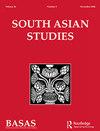Motivated Reading: Text and Image in the Expanded Temple
IF 0.7
0 ASIAN STUDIES
引用次数: 0
Abstract
While generations of scholars have recorded the rock-cut inscriptions found on the walls of southeast Indian temples, not until recently has attention been given to the inclusion of text in murals of the same region and locations. Epigraphists and historians of all stripes have focused mainly on the semantic content of text, largely ignoring the materiality, placement, and legibility of the inscriptions themselves. However, a more recent turn to the study of materiality has refocused attention on these issues. Emerging from an art historical perspective, this essay argues that the study of murals can methodologically enrich a reading of inscriptions, no matter their medium. This essay argues that the images and texts that adorn temple walls, both carved in stone and painted in murals, may be best understood within a larger matrix of aesthetic experience that neither reduces them to their materiality nor removes them from a contextually-specific reading.动机阅读:扩展寺庙中的文本与图像
虽然几代学者已经记录了在印度东南部寺庙墙壁上发现的岩石雕刻的铭文,但直到最近才注意到在同一地区和地点的壁画中包含文字。各种各样的铭文学家和历史学家主要关注文本的语义内容,而在很大程度上忽略了铭文本身的物质性、位置和易读性。然而,最近转向研究的重要性重新关注这些问题。本文从艺术史的角度出发,认为对壁画的研究可以在方法上丰富对铭文的阅读,无论它们的媒介是什么。本文认为,装饰寺庙墙壁的图像和文字,无论是刻在石头上还是画在壁画上,都可以在更大的美学体验矩阵中得到最好的理解,既不会将它们减少到它们的物质性,也不会将它们从上下文特定的阅读中移除。
本文章由计算机程序翻译,如有差异,请以英文原文为准。
求助全文
约1分钟内获得全文
求助全文

 求助内容:
求助内容: 应助结果提醒方式:
应助结果提醒方式:


